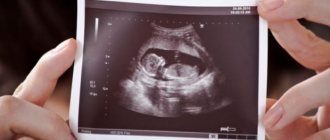Just the other day you found out that you are pregnant and for days now you have been “studying” all sorts of thematic sites and resources in order to learn as much as possible about pregnancy? Then our publication will also be very interesting for you. After all, every expectant mother wants to know when her little person, who is inside, begins to beat.
Obstetricians, doctors and experienced mothers claim that with normal fetal development, the unborn baby’s heart begins to beat on the 21-25th day of his “intrauterine” life. Moreover, we note that the baby’s heart beats at a speed of 140 beats per minute. However, in order to calculate this period and know for sure when to expect the first “sound” of the baby’s heart, it is necessary, first of all, to understand the process of embryo formation itself. Which is exactly what we will do now.
Emergence of the embryo
It's no secret that at the moment of emergence, a person is just one egg fertilized by a sperm. We also know from the school curriculum that a fertilized cell moves to the uterus through the fallopian tube for up to five days, and from the first hours the cell begins to actively divide, so as a result, a multicellular organism arrives in the mucous membrane of the uterus, which is called an embryo. Subsequently, with normal development, the embryo grows into the uterus with its cells and actively develops for nine months.
How the vascular system and heart are formed in the embryo
- From about 4 weeks of pregnancy, embryonic development begins. It is within 4-10 weeks that the main organ systems are formed - nervous, circulatory, muscle and bone. This period is very important in the development of the fetus, since some actions of the expectant mother or consumption of certain foods can lead to complications.
- By the beginning of the second month of pregnancy, the embryo does not yet closely resemble the future human being. The baby is pear-shaped and consists of 3 layers, each of which is responsible for the development of a particular system. The outer layer, the ectoderm, is responsible for the development of the skin and neural tube. And the latter, in turn, is for the development of the brain and spinal cord.
- The inner layer, the endoderm, is responsible for the development of the intestines and lungs. And finally, from the middle layer - the mesoderm - the heart and circulatory system will develop. If you are wondering at what week of pregnancy the fetal heartbeat appears, then I can confidently answer that already at 5, since by this period it begins to pulsate in the embryo. By this time, the development of the main human organ had already passed several stages. This process is quite difficult, so let’s take a little look at what week of pregnancy the moment of conception occurred and what main stages the heart goes through until the moment it begins to beat.
At 2-3 weeks of development, the foundations are laid and large vessels of the heart begin to develop. At the very beginning, it looks like two tubes that gradually join together. This tube begins to grow so actively that after a short amount of time, it no longer has enough space in the chest, it has to bend and narrow.
- This process results in an organ that is very similar to the human heart. By about 4 weeks, a constriction is formed, which divides it into two sections - venous and arterial. And by 6 weeks the arterial duct is formed, and by 10-12 weeks the venous duct begins to work. From the 5th week, a septum begins to form, which divides the common atrium into right and left.
- After a little more time, another septum will appear in the three-chambered heart in the area of the ventricles. And as a result, by approximately 6-8 weeks of pregnancy the baby has a full-fledged, human, four-chambered heart. It has some other features that are characteristic of an intrauterine organ. But with birth, when the baby’s lungs are involved in all processes, everything will fall into place.
At what stage does the heart begin to beat and how can you listen to the heartbeat that appears in the fetus?
Most often, the expectant mother does not notice those symptoms that may hint to her that a belly has settled in her stomach. But there is another type of woman who feels when life is born in them, almost from the first minutes.
The heart is, if not the most important, then certainly one of the most important organs in human life. That is why every mother wants to make sure that her baby is healthy and nothing interferes with his life. In order to study the functioning of this organ, the following are used: ultrasound, echocardiography, CTG, auscultation (listening to the fetus).
It is worth noting that at such early stages the most effective method is ultrasound. It makes it possible not only to listen to the heart rate, but also to look and verify the correct location of the organ in the chest. The least effective method for this period is listening to the embryo.
Since when it just begins to beat, its blows do not yet have such force as to drown out the mother’s heartbeat. Echocardiography is possible only according to a doctor’s indications. It is aimed not only at studying the structure of this organ, but also at analyzing the work of large vessels.
To identify defects, an additional “four-chamber” section can be performed. This is one of the possible ultrasound examinations that helps to see all four chambers of the heart at the same time - two ventricles and two atria. Such a study helps to identify 75% of possible deviations.
Formation of the circulatory system and heart formation
From the first minutes of its existence, the embryo needs energy and oxygen, which are supplied by the circulatory system. Initially, the fetal body is entangled in a hollow tube - the embryo’s circulatory circle, but on the 22nd day a contraction appears in the bend of this tube. Further - more: the pulsation intensifies, blood from the mother’s body is pumped through the pipe and the unborn baby, in the end, begins to pump blood independently. It is at this moment that the fetus develops a single-chamber heart.
More on the topic
Fetal heartbeat during pregnancy
When can you feel the first fetal movement during your second pregnancy?
When does pregnancy occur after conception and ovulation?
Fetal development by week of pregnancy
When do fetal movements begin during pregnancy and how to recognize them?
The work of the future baby's heart ensures its growth, and the hollow tube is filled with a muscular septum, which allows the organ to increase in volume and become two-chambered. Heart formation can also be seen on ultrasound at the end of the sixth week. After this, over the course of two weeks, the atria, ventricles, blood vessels and dividing valves are formed. Well, at the end of the second month of life of the intrauterine fetus, a four-chambered heart is formed, which completely corresponds to the heart of an adult.
What methods are used
In order to hear the baby’s heartbeat, experts suggest using different examination methods:
- Ultrasonic. This method can be transvaginal. With the help of modern diagnostic devices using ultrasound, you can listen to the heartbeat of the embryo at 5–6 weeks of pregnancy. When using the transabdominal ultrasound examination method, the first beat is detected already in the period of 6–7 weeks.
- Stethoscope. A pregnant woman is periodically examined by a specialist, a gynecologist, who uses an obstetric stethoscope to auscultate the woman’s abdomen. Using this method, the gynecologist determines the condition of the fetus in the womb. An obstetric statoscope makes it possible to hear the fetal heartbeat at approximately 18–20 weeks.
- On one's own. Without the help of a specialist at home, even with the help of a statoscope, it is quite difficult to listen to the fetal heartbeat. This is due to the fact that many extraneous noises are added to the baby’s heartbeat, as well as the mother’s heartbeat. But if you really want, you can buy a Doppler detector for detecting fetal beats. With its help, you can listen to the frequency and rhythm of the child’s heartbeat and its pulsation through portable headphones. If desired, it is possible to capture these sounds by making an audio recording.
The fetal heart begins to beat approximately 5–6 weeks after pregnancy is established. It is during this period that you can hear the baby’s heart beat for the first time.
How to listen to the fetal heartbeat?
On the 22nd day after conception, the expectant mother can hear the fetal heartbeat, but only with the help of transvaginal ultrasound or an obstetric stethoscope. Well, if you want to enjoy the heart impulses of your unborn baby at home, you can purchase a Doppler fetal heartbeat detector. Thanks to this device, you can not only listen to your baby’s heartbeat through headphones, but also record an audio recording on your computer.
Heartbeat
“At what week does the heartbeat appear?” There are several possible answers to this question.
- 5 weeks after conception. Starting from 3 weeks after conception, the circulatory system of the embryo begins to actively form. In this case, the vascular wall in its bend contracts for the first time. Every day the pulsation becomes more frequent and confident. In addition, at this time, blood begins to pump through the vessel, and the child switches to independent blood circulation, which is ensured by the presence of a single-chamber heart.
- At 6 weeks pregnant. Using a method such as echoscopy, you can hear the first heartbeat of the fetus. At this time, partitions appear in the tube, which consists of muscle and connective tissue. As a result of this, the heart enlarges, and two sections are already formed in it. As for the final formation of the atria and ventricles, septa and valves, blood vessels and conduction system of the heart, it ends at 9 weeks from the start of pregnancy.
- On day 22. The heart already has a fully formed structure. Before labor begins, it increases in size and weight.
I would like to note that the period from 4 to 8 weeks of pregnancy is the most dangerous for the fetus. It is during this period that there is a high probability of the formation of various heart defects.
Interesting Facts
Many expectant mothers ask why the heart begins to beat strongly for no apparent reason. Will this affect the development of the embryo, and is this at all related to pregnancy? The clear answer is yes, rapid heartbeat and pregnancy are directly related. The reasons for the appearance of such sensations may be:
Normal fetal heart rate
Until 6 weeks of pregnancy, the cardiac activity of the embryo is just forming, so the rhythm of heart contractions is slow. After the formation of a connection between the circulatory and nervous systems, by approximately the 9th week of pregnancy, the heart rate (HR) increases to 170-180 beats per minute. After some time, it decreases slightly again and from the second trimester of pregnancy is usually 120-160 beats/min. In the 2nd and 3rd trimesters, the pulsation should be rhythmic.
The fetal heartbeat is one of the most important indicators of normal intrauterine development of a child, so doctors always closely monitor it. Alarm is caused by heart rate values less than 85-100 beats per minute or more than 200. The absence of a heartbeat in the fetus, when it has reached a size of more than 8 mm, indicates a non-developing pregnancy.
The hearts of mother and child are connected from the first days of pregnancy not only physically, but also spiritually. Take care of your health and mood - your little heart will thank you.
The correct development of the fetus is determined by parameters, depending on what stage and month of pregnancy the examination was carried out. Each week is characterized by its own parameters.
So, until the 6th week, the cardiac contraction of the embryo is slowed down. By week 10, the number of contractions should be increased to 180 beats per minute. From the second and third trimester, the pulsation is 120-160 beats and should be rhythmic. The heartbeat of a future person is an important indicator of normal intrauterine development. If the size of the fetus is 7-9 mm, and there is no beating, then this indicates a frozen pregnancy.
It is necessary to monitor the health of a pregnant woman, since it determines how the future baby will develop.
The heart rate of the fetus at the initial and final stages of intrauterine development varies. Based on the pulse, rhythm and pattern of the heartbeat, the doctor determines the health status of the embryo.
The initial rhythm of the embryo's heart coincides with the mother's heartbeat, about 90 beats per minute. Every day your heart rate will begin to increase by 3 beats per minute.
A specialist can accurately calculate the gestational age based on the fetal pulse.
Gradually, the heart rate increases and by eight weeks it already reaches from 130 to 160 beats.
By the ninth week of pregnancy, the fetal heart rate is 175 beats per minute. At each stage of fetal development, your heart rate will fluctuate.
In the second semester of pregnancy, the baby's pulse should not be higher than 160 beats/min, but at the same time it should not slow down to 85 beats. Exceeding the norm indicates the presence of abnormalities in fetal development. If the embryo's pulse is higher than normal, the fetus may be experiencing oxygen starvation.
How many heartbeats per minute does a fetus have in the womb?
- In the early stages (up to 6 weeks), the fetal heart contracts slowly. This is explained by the initial stage of the formation of cardiac activity.
- When the connection between the circulatory and nervous systems is formed (which happens by the end of the 9th week), the heart rate is already 170-180 beats per minute.
- However, such heart rate indicators do not last long: by the second trimester, heart rate indicators decrease to 120-160 beats per minute. The second and third trimesters occur with the rhythmic pulsation of a small heart.
How to listen to the fetal heartbeat
Organ formation
The cardiovascular system is one of the first to be formed in the body of a developing fetus. Already in the very early stages, it has an important “mission” - to ensure embryonic blood flow. Its normal development determines whether the baby will grow or the pregnancy will be terminated, whether the heart will remain healthy or whether its defects will be discovered.
The fetal heart is formed at the end of the 2nd week of gestation . This means that mom may have already begun to suspect that she is pregnant. The first two heart tubes form. They gradually merge into one. Blood is already flowing into it, but so far in a single continuous flow.
By the end of the 3rd week of gestation (a week from the start of the delay), the structure of the tube changes and becomes more complex.
During this period, it is important to avoid contact with chemicals, radioactive substances, and not to take medications without the knowledge of the doctor, who has already been informed about the “stripe” test.
Any unfavorable external or internal factor can influence the development of cardiac pathologies at this stage - severe stress, maternal worries, viral infections, bad habits.
By the beginning of the 4th week from the moment of conception (only about 9-10 days will pass from the start of the delay), the child’s heart will become sigmoid (shape resembling a Latin S). The primary ventricle and atrium will be formed in it. By the end of the 4th week of gestation, the still single-chamber heart is already beginning to contract, but it is still impossible to hear the beat - the size of the organ is too miniature.
At the 4-5th week of gestation, the parts of the heart grow, a septum forms between them - the organ becomes two-chambered. For now, the child only has a systemic circulation (after all, there are no lungs yet).
At the 6th week of pregnancy, the heart becomes 3-chambered, and after a few days it becomes 4-chambered, since the ventricular section is separated by a flexible septum.
The process of formation of septum in the fetus is completed by the 7th week.
For the remaining 7 months, the organ will only increase in size and work uninterruptedly, supplying the child’s other organs and systems with blood. The frequency and rhythm of the baby's heartbeat is an important indicator during pregnancy. Using it, doctors will judge how well the child feels, how well he is developing, and whether he has enough oxygen.
How does the heart develop?
The process of heart development is quite complex and also very long. The first formation begins to appear in the 4th week of pregnancy, and already in the 5th week its pulsation is slightly audible. By the end of pregnancy, the tiny heart already consists of four chambers, but despite this, it is significantly different from the organ of adults.
At this stage of modern life, the baby’s heartbeat can be heard using various devices. The first thing you are interested in is how many weeks does the fetal heartbeat appear and how to listen to it? For example, in the early stages, heartbeats can be detected with a vaginal ultrasound sensor, and later - with an abdominal one.
Can a woman feel the fetal heartbeat?
Despite the fact that the period when a fetal heartbeat appears is only 4 weeks, the expectant mother will not feel a heartbeat either in the second or in the ninth month.
What women often mistake for the baby's heartbeat is the pulsation of their own aorta. It can be felt in the abdomen or lower back. Occurs due to increased pressure in this vessel.
If you experience palpitations in your stomach or lower back during pregnancy, contact your gynecologist. You may also need to consult a cardiologist.
Video: Fetal heartbeat in early pregnancy
- The venous and arterial sections, which have grown over time, are separated by a deep constriction, after which the formation of a two-chamber fetal heart begins. This happens in the 4th week of development.
- Now the baby has only a systemic circulation. After the lungs are formed, the pulmonary circulation will develop. The size of the heart is tiny and resembles a poppy seed, but it works clearly and rhythmically.
- At the 5th week or at the beginning of the 6th (this is the seventh obstetric week), the baby’s heart is already three-chambered due to the appearance of the interatrial septum.
Stages of Heart Development
- 6th week of development: the ventricular chamber is divided by a septum. At this stage, valve formation also occurs. The common arterial trunk is now divided. As a result of this division, the aorta and pulmonary artery appear. This is how the fetus develops a four-chambered heart. Heart rate is recorded: about 150 beats per minute. The heart rate of an adult is half that.
- At 6-7 weeks the fetal heart is almost formed. At this stage, the construction of the septum between the ventricles continues. Once the septum has formed, the left and right ventricles will be separated.
- At the 8th week, the baby’s heart is shaped like an adult’s heart, with the only difference being that inside the small heart there is an oval window located between the atria and the ductus arteriosus. This window connects the aorta to the pulmonary artery and ensures the supply of oxygen from the mother’s blood directly to the fetal organs. Since after the baby is born there is no longer a need for such a window, it closes.
Supply of nutrients and oxygen to the fetus
At what stage of intrauterine development does the heart begin to contract?
Obstetricians divide the prenatal period into two stages: embryonic, which lasts the first two months of development, and fetal, that is, the fetus. The fetal period lasts from the third month until the birth of the child. It is from the third month that doctors begin to call the child not an embryo, but a fetus.
The first heartbeats begin at the embryonic stage of development on the 22nd day after conception, and just four days later the heart begins to circulate blood through the already formed circulatory system. In the fifth and sixth obstetric weeks of pregnancy, it is already possible to record the baby’s heartbeat.
How to listen to the fetal heartbeat
There are several ways to hear the first beats of a small heart:
- Ultrasound diagnostics. With the help of modern ultrasound diagnostic devices, it is possible to hear the beating of a small heart in the very early stages of pregnancy. With the help of a transvaginal (internal) ultrasound, the heartbeat can be heard when the pregnancy is only five weeks old. And after just one week, heartbeats can be heard during a transabdominal (external) ultrasound examination.
- Examination with a stethoscope. The specialist can listen to the fetal heartbeat using a stethoscope. During the examination, the doctor places a tube with an expanded funnel at one end to the pregnant woman’s stomach. Using this method, it is possible to obtain data on the development of the baby. As the child develops, the beating of his heart becomes more and more clearly audible. Thanks to a stethoscope, it is possible to hear the baby’s heart from the eighteenth week of pregnancy.
- At home. It is very difficult to hear the baby’s heart at home using a regular stethoscope, because the sound of the heartbeat is added to other sounds that the body of the pregnant mother makes. If you want to be able to listen to your baby's heart at home, you can buy a compact Doppler fetal heartbeat detector. The device makes it possible to hear the baby’s heart through special headphones. You can also save these sounds as a memory in any convenient format on the hard drive of your computer.
When can the heartbeat be heard?
Human development begins with one cell - the zygote. From the day of conception to birth, tremendous growth and formation of the body's main systems occurs.
This is practically a miracle that happens hidden inside the mother’s body. In the early stages, the fetus's tiny heart begins to beat. It can be heard using various methods.
How the process of development of a still tiny heart occurs is known to humanity today.
Heart development
At the moment of conception, two cells fuse together to form a zygote. It is implanted into the wall of the mother's reproductive organ and from that moment pregnancy occurs.
A woman’s body undergoes colossal hormonal changes. The hormone hCG begins to be actively produced. About 200 million new cells of the human body are formed from one zygote.
Development goes through three periods:
- The pre-implantation period, when the fertilized egg has not yet implanted into the wall of the uterus.
- The period of organ formation. After connecting with the mother’s body, the chorion begins to produce the hCG hormone, which can be used to determine whether pregnancy has occurred.
- The embryo acquires the ability to exist independently, as its organs acquire their own specialization.
The circulatory system is one of the first to form. Almost at the 5th week, the little man already has the rudiments of its functioning. On ultrasound, a heartbeat can already be heard in the very early stages of pregnancy.
This indicates normal fetal development. Significant changes also occur in the mother's body.
The increasing concentration of hCG adjusts the woman’s body to create conditions for a normal pregnancy.
Embryo development occurs gradually. By the 4th week of obstetrics, cells are divided into 3 types. One of them will subsequently become the circulatory system, bones, muscles and kidneys.
By the 5th week of obstetric count, a vascular tube is formed. It's hollow inside. This is what the primary circulatory system looks like. It is this system that will later be visible on an ultrasound as the heart. On the 22nd day from the day of conception, the first impulse occurs. It is not yet controlled by the nervous system.
By day 26, the small heart can already be heard quite clearly. It begins to pump blood throughout the fetal body on its own. At the same time, you can notice its certain rhythmicity on ultrasound. In this case, the heart is still visible on examination as single-chamber.
When the concentration of the pregnancy hormone hCG is still increasing in the mother's body, the fetal heart is in the process of formation. By week 7, the embryonic heart septum appears. It divides the organ into chambers. This is the right and left compartment. The fetal heartbeat during this period is heard as 150 beats per minute. This is normal during pregnancy.
By 10–11 weeks of pregnancy, ultrasound can already show 2 ventricles, as well as 2 atria of the organ. Vessels and valves are also visible. Between the atria and the ductus arteriosus there is still a foramen ovale. This allows oxygen from the mother’s body to flow to the embryo’s life support systems.
The final structure of the fetal heart appears on ultrasound only at 22 weeks of pregnancy. Next, the network of blood vessels grows and the muscle mass of the organ increases. When the baby is born, the oval window closes.
There are several ways to hear the fetal heartbeat. This will be interesting to know for future parents who are looking forward to the birth of their baby. This will allow you to get at least a glimpse of the miracle that is now happening in the mother’s womb. Ways to hear the pulse of a tiny heart include:
- Transvaginal ultrasound.
- Stethoscope.
- Portable detector.
The first way to determine when the fetal heart began to beat is by ultrasound using a transvaginal sensor. During this period, any pregnancy test shows a positive result due to the high concentration of hCG. This is possible already by 4 weeks of embryo development. After 7–10 days, this can be heard with the help of an external ultrasound examination.
In addition to ultrasound, it is possible to listen to the baby’s heart beat at a later date. For this, the gynecologist uses a stethoscope. He places the device on the expectant mother’s tummy and picks up the impulses. How long it will take to be able to detect a distinct pulse can only be said approximately. It clearly appears by 18–22 weeks.
At home you can hear the beating of a small heart. But it's quite difficult. When the fetal pulse begins to beat, a portable device - a Doppler detector - will be able to pick up this sound.
READ How to remove tachycardia at home
Even when the level of hCG in the blood is not yet too high, and the fetus is still barely visible during ultrasound diagnostics, this device transmits an impulse using headphones.
It will even allow you to record these sounds on your computer.
Established norm
During each period of development of the baby’s circulatory system, the rhythm of his heartbeat changes. He either slows down or speeds up. This can be seen during ultrasound examination. Therefore, future parents need to know what is considered normal and at what point in time. Three main stages can be distinguished:
- At 5–6 weeks, the activity of the heart muscle is just being adjusted. The rhythm is normally slow.
- At 8–9 weeks, the connection between the nervous and circulatory systems is visible. The contraction of the baby's heart muscle is about 170 beats per minute.
- At 13–14 weeks, the mother's hCG level decreases. At this time, the pulse slows down again. It equals 120–160 beats per minute.
You should also know that in the second and third trimester, heart contractions should be rhythmic. A pulse that is too slow or fast suggests certain pathologies.
In the earliest stages of the development of new life inside the mother's body, the heart rate of a woman and her baby are closely linked. Therefore, it is necessary to carefully monitor your health and reduce physical and emotional stress. This will help the baby’s circulatory and other body systems develop correctly.
The ability of the fetal heart in the vagina to pump blood and pulsate does not mean that its beating can be heard.
According to experts, the period when the fetal heartbeat is heard is 21-22 weeks of pregnancy.
Until this time, the heartbeat is still very weak and unstable. Even with the most modern equipment, it is impossible to feel the sound of a heartbeat during early pregnancy.
After 21 weeks, using a statoscope or Doppler detector, the sounds of the fetal heartbeat can be clearly heard.
At this period, it is extremely important to conduct an ultrasound examination of the child’s condition.
If there are any pathologies of heart development, ultrasound will help identify them at an early stage of pregnancy.
Some women neglect this possibility, which can lead to the birth of children with congenital heart defects.
Diagnostics
All future parents are concerned about the question of how long it takes to hear the first heartbeats. And for good reason, since this is an important indicator that helps determine how correctly the cardiovascular system is formed and how the embryo and fetus are developing.
In the early stages of embryogenesis, ultrasound examination is performed. It makes it possible to hear the heartbeat of the embryo at 5 weeks when using a transvaginal sensor or at 7 weeks when using a transabdominal one. It should also be mentioned that the frequency of contractions varies depending on the gestational age.
Auscultation with an obstetric stethoscope is a method that comes from antiquity, but has one drawback. It is possible to listen to heart sounds no earlier than the beginning of the third trimester.
During this period, every time a woman visits an obstetrician-gynecologist, this examination is carried out. It allows the doctor to judge the progress of pregnancy and the condition of the baby in the womb. For this purpose, an external obstetric examination is first performed, and then the stethoscope is placed in the place of best listening to the heartbeat.
Cardiotocography is a method of recording the work of the fetal heart and the tone of the uterus with the results displayed on a calibration tape. Diagnosis can be carried out from the 22nd week of pregnancy, however, according to orders, it is prescribed at least 3 times in the third trimester and during the birth process.
In assessing the development of an embryo or fetus, it is important not only to catch the moment when the first heartbeat appears.
It is necessary to monitor the process of proper organogenesis in order to timely diagnose congenital anomalies.
For this, echocardiography is performed, which allows you to calculate the size of the heart and large vessels, visualize cardiac structures, as well as existing abnormalities.
With Doppler ultrasound, it is possible to assess blood flow.
If pathological abnormalities are detected, the issue of termination of pregnancy or surgical intervention is decided immediately after birth.
One of the signs that a baby is growing inside the womb is a heartbeat. What time does a fetus's heart begin to beat? Let's talk about this.
How and at what time can the baby's heartbeat be heard in the womb?
Ultrasound
- A woman can hear her own baby's heartbeat in the early stages of pregnancy. This opportunity appears during the next examination using an ultrasound diagnostic device.
- With transvaginal (internal) ultrasound, the heartbeat can be heard at 5-6 weeks. At this stage, the embryo is only 3-4 weeks from the moment of conception.
- Transabdominal (external) ultrasound allows you to hear the baby’s heartbeat at 6-7 weeks.
Stethoscope
- Using a medical instrument called a stethoscope, a gynecologist listens to the beating of a tiny heart. This happens during an examination of a pregnant woman. The instrument used to perform auscultation (that is what this method is called) is a tube, usually made of wood.
- At the end of the tube there is a wide funnel, which the doctor places on the pregnant woman's stomach and listens to the tiny heart beating. Such listening is carried out not just out of curiosity: the doctor assesses the condition of the baby in the womb. Over long periods of time, the heartbeat can be heard very clearly.
- A stethoscope is used at the appointment after 18-20 weeks of pregnancy. Only at this stage can you use it to listen to the baby’s heartbeat.
How and at what time can a baby's heartbeat be heard in the womb?
At what week does the fetal heartbeat appear: norms and possible deviations
It is important throughout pregnancy to monitor not only the well-being of the mother, but also the baby. The most significant thing in the development of the fetus is the proper functioning of the heart; the baby’s vital activity depends on the heartbeat. The work of the little heart is closely monitored, since the slightest deviation can cause developmental problems. So at what week does the fetal heartbeat appear and from how many weeks can it be heard?
How does the heart develop?
The process of heart development is quite complex and also very long. The first formation begins to appear in the 4th week of pregnancy, and already in the 5th week its pulsation is slightly audible. By the end of pregnancy, the tiny heart already consists of four chambers, but despite this, it is significantly different from the organ of adults.
At this stage of modern life, the baby’s heartbeat can be heard using various devices. The first thing you are interested in is how many weeks does the fetal heartbeat appear and how to listen to it? For example, in the early stages, heartbeats can be detected with a vaginal ultrasound sensor, and later - with an abdominal one.
Normal heart rate (HR) in the fetus
To determine the normal heart rate per minute, it is necessary to take into account the duration of pregnancy, since the number of beats differs every week - this is normal.
At what time does the fetal heartbeat appear?
- at 6-8 weeks, the heart rate per minute is 110-130 beats;
- at weeks 8-11, maximum heart rate is 190 beats per minute;
- after week 11, contractions reach 140-160 beats per minute.
When listening, the condition of the pregnant woman, the time of the procedure and the activity of the baby are taken into account.
Methods for listening to the heartbeat
Many people are interested in what week the fetal heartbeat appears. There are many ways to hear the heartbeat.
The most common and accurate are:
- Ultrasound. Experts advise every pregnant woman to undergo an ultrasound examination both during registration and for further monitoring of fetal development. Nowadays, with the help of ultrasound, you can not only examine in detail the development of the baby in the womb, but also hear the work of the heart. This method helps to study the condition of the placenta and the fetus as a whole, and with its help you can see all deviations (if any) and begin to eliminate them in a timely manner. When does fetal heartbeat appear on ultrasound? It can be heard from the sixth week.
- Auscultation. The examination is carried out by a specialist with a special medical device - a stethoscope; this method is used only after the 18th week of pregnancy at each examination by a gynecologist.
- Cardiotocography. This technique is very effective, it allows you to study the baby’s heartbeat in detail, as well as identify deviations even in the early stages of pregnancy. This method is mainly used after 32 weeks or before childbirth.
- Echocardiography. This method is used when there is a suspicion of a heart defect in the fetus. It is used at 18-28 weeks of pregnancy.
Timely research helps to avoid abnormal development, as well as identify all heart rate deviations and immediately begin their treatment.
How to hear your baby's heartbeat yourself
In addition to medical monitoring, the expectant mother can independently check the baby’s heartbeat. Such methods will help you be confident in the development of the fetus and, in case of any concern, seek help. At what week does the fetal heartbeat appear, which can be heard using different devices:
- Stethoscope. This medical device can be purchased at a pharmacy and is inexpensive. To detect the baby's heart rate, the expectant mother will need an assistant. The only drawback of this method is that the baby’s heartbeat can be heard no earlier than the 25th week of pregnancy. Also, very often women perceive the sounds of fetal movement as a heartbeat.
- Fetal Doppler. This is a special device designed to control heart contractions. It has headphones, which make listening convenient and easy. This device is expensive, but it allows you to determine your heartbeat at 8-10 weeks. Experts warn: you should not use such instruments often, so as not to harm the baby’s health, and you should also listen to the heartbeat with such a device for no more than 10 minutes.
- Attaching the ear. The method is quite simple and effective (if the fat layer is not too large). Starting from the 30th week, the baby’s heartbeat can be heard by placing your ear to the stomach, focusing on the location of the heart.
How is the control carried out?
Monitoring your baby's heartbeat is very important from the beginning of pregnancy until delivery. This will allow the child to be born healthy, without any abnormalities.
The heart of an unborn child takes a very long time to develop; it has a complex structure compared to other organs. The organ is formed starting from the 4th week, during this period a hollow tube is formed, on which the first contractions are observed in the 5th week. And already on the 9th, the structure of the tiny heart resembles an adult one. The baby's heart in the womb is very different from a normal organ - it has an opening between the right and left atria, as well as between the arterial flow. This structure helps oxygen flow to all the baby’s organs.
The viability of the fetus is determined by the heartbeat. If the beats per minute are less than 86-100 or more than 200, this is a cause for concern. If the embryo grows to 8 mm and the heart cannot be heard, then this indicates fetal fading. It is important to register during pregnancy and undergo regular routine examinations with a gynecologist.
Determination of the norm and deviation of heart rate in the fetus
At the initial stages of the heart rate study, it is carried out only using an ultrasound machine. In the first trimester, this parameter remains unchanged. After this period, the frequency of contractions begins to increase. The normal heart rate by the 8th week should reach 130 beats per minute and not exceed this figure. At the 9-10th week, contractions per minute reach 180-190 beats, and from the 11th week until the baby is born - 140-160 beats per minute.
In the later stages, the heart rate will depend on the activity of the child in the womb, as well as on the stress of the mother herself, illness, temperature changes (extreme cold or heat). If the fetus lacks oxygen, its heart rate increases to 160 beats, and after saturation with gas, on the contrary, it drops to 120 beats per minute.
When the fetal heart is properly formed, its sounds are rhythmic and well audible. If intrauterine development is abnormal, arrhythmia or hypoxia is observed, and it also indicates a congenital defect of the organ.
If the heart is hard to hear
Many women know at what week the fetal heartbeat appears. But there are situations when the heartbeat is difficult to hear, this happens due to the location of the placenta on the anterior wall of the uterus. It is also problematic to listen to heart rate in case of oligohydramnios or polyhydramnios, multiple pregnancy, obesity, or increased activity of the child.
In the second and third trimesters, the purpose of ultrasound examination is not so much to assess the functioning of the heart, but to determine the location of the organ. In cases where it is necessary to examine the heart in detail, echocardiography and cardiotocography are performed - with the help of these studies you can monitor the baby’s heartbeat.
Diseases due to heart rate disturbances
Often, when the heart rate deviates, the following diseases appear:
- Tachycardia - appears in the fetus due to abnormal development or due to the fault of the mother. A specialist can determine the disease using medical equipment.
- Bradycardia - appears due to a low fetal heart rate.
Timely diagnosis of diseases will help you begin quick and necessary treatment, so it is very important not to forget to undergo examinations and visit a gynecologist.










